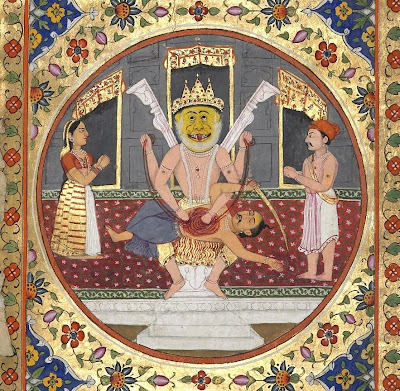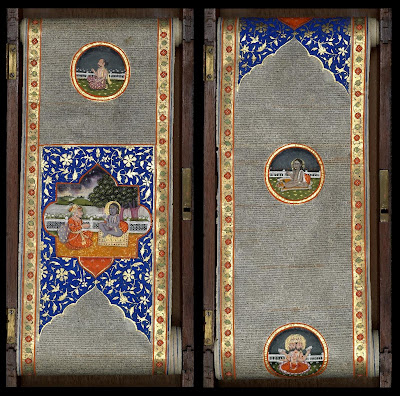







The vast and exceedingly complex body of work that constitute the Hindu scriptures consists, in the most simplistic terms, of the ancient Vedas (rituals, mantras, hymns); the Upanishads (spiritual interpretation of the Vedas); the post-Vedic literature (including such epics as the Ramayana and the Mahabharata); the Bhagavad Gita or Divine Song (a kind of practical guide to life); and the Puranas (mythological tales about the origins of the world, culture and deities).
The Bhagavata Purana concerns itself with the exploits of the Hindu god Vishnu in his various incarnations (avatars), and particularly as Krishna. It records a dialogue between a King who has 7 days left to live and a Saint who agrees to teach the King about the meaning of life. The purpose of the Bhagavata Purana is to enable a person to overcome the fear of death by the process of bhakti yoga - the spiritual practice of cultivating a loving devotion to the Supreme God-of-Gods.
The images above come from a 45 feet long, 17th century silk-paper illuminated scroll, which is obviously mounted in a wooden box. This sacred Bhagavata Purana scroll is hosted by the Rylands Library at the University of Manchester - it employs a LunaInsight browser arrangement [search on 'hinduism']. I've posted about 2/3 of the available images and the details above are all spliced screencaps - click on the images for larger versions.
- Hindu scripture/Bhagavata Purana at wikipedia.
- 'Stories of Krishna: The Adventures of a Hindu God' - an excellent presentation from Seattle Museum based on artworks of Krishna (audio/flash).
- Śrīmad Bhāgavatam (Bhagavata Purana) - the text.
- I preferred the childrens' version: 'Tales From The Bhagavatham Retold For Children by PS Krishna Iyer.
- 'Manas: India and its Neighbours' at UCLA.
- 'The Invention of the Hindu' from Axess Magazine (cache) via a great Metafilter post.




























4 comments :
I have rarely seen such a cheerful-looking depiction of disembowelment (then again, how many images of this have I seen? fortunately rather few), or for that matter dismemberment. I wonder whether reading the texts mentioned would prompt this sort of remarkable calm, or if I am just not ready for it in this lifetime... (have not been educated in bhakti yoga)
Note: I am glad to see that, as I might have expected, the word "simplistic" is used properly in this post. For some reason my students love to use this word when they really mean "simple," so I have developed an unfortunate pedantic obsession about its use. (It's much more fun when they're psychotic or on drugs and write about how the pyramids have clerestory windows in order to keep the light out.)
this blog is great !
eclectic, cultivé, rich, amazing, a kid of cabinet des curiosités. thank's for this great work.
I've copied down the first image, with the intent of reproducing it one day - gorgeous!
How can Śrīmad-Bhāgavatam (Bhāgavata-Purāṇa) be a 'hindu' scripture when it was compiled over 4,000 years before the British invented 'hinduism'? The word 'hindu' does not appear anywhere in the Vedas; it is a Persian racial slur. The British wanted to undermine the spiritual basis of Vedic culture, so they lumped all the local religions together under the label of 'hinduism'. If you doubt this, Google 'British created hinduism.'
Post a Comment
Comments are all moderated so don't waste your time spamming: they will never show up.
If you include ANY links that aren't pertinent to the blog post or discussion they will be deleted and a rash will break out in your underwear.
Also: please play the ball and not the person.
Note: only a member of this blog may post a comment.